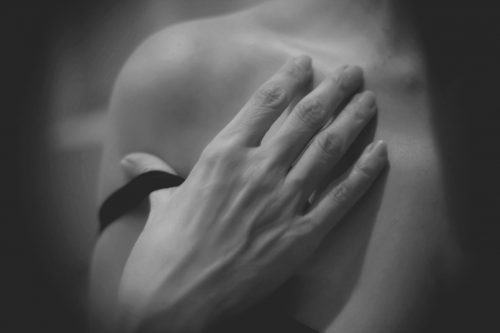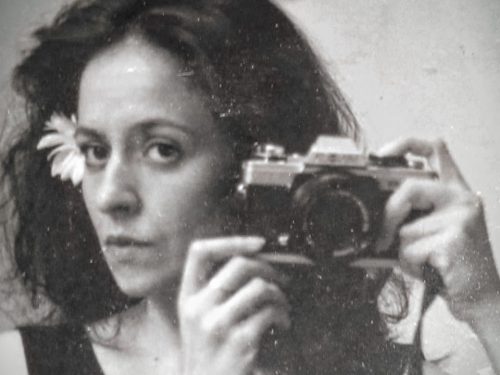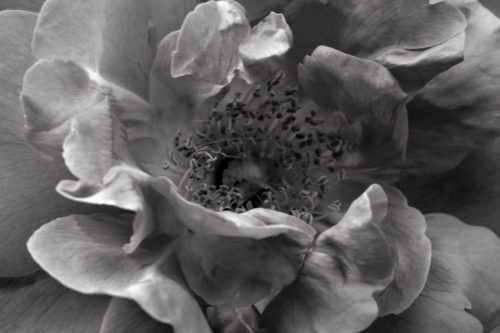
(c) Marie Thérèse Blanc
I don’t know about you, but when I think of American photographer Robert Mapplethorpe, I think of the height of his notoriety in the 1980s, when he photographed the rich and famous the way Rodin sculpted busts for his aristocratic patrons. In his spare time, Rodin went on to create the Gates of Hell, and Mapplethorpe took his most dynamic photographs of the gay S&M scene. In certain circles, he could do no wrong, and he travelled swiftly from the underground of lower Manhattan to the salons of the Upper East Side, an arresting prince who was paradoxically gentle and ambitious. When I think of him, I think, yeah—I had style back then myself. But it’s easy to have style when you are young, attractive, smart, intellectually curious, and willing to travel in circles known for complicated but fascinating members. It was easy for me in the Montreal of that time. As I came of age in the 1980s, Montreal changed along with me—we grew up together, this city and I, from awkward things to sophisticated, open-minded entities.
When I settled here with my family in 1967, frozen fish sticks were considered good fare and by the time Pierre Trudeau was elected prime Minister of Canada a year later, frozen broccoli became available as well, but you couldn’t find fresh broccoli stalks at your local Steinberg’s or Dominion store. There were no baguettes—you ate POM sliced white bread or you went without, and you drank powdered instant coffee; there were no lustrous coffee beans or home grinders, no Greek yogurt, no prosciutto, no fresh figs, no oyster bars filled with gargantuan Kelly oysters, no chestnuts from Italy to roast on a Fall day, no jasmine green or Earl Grey tea, no bottled water from Iceland, no creamy French-milled soaps, and Coty was considered a serious perfumer. Montreal was no different from Detroit at that time: it was a city of narrow working-class tastes. But by the 1980s, the city exploded into sensuality as it opened itself up to foreign cultural influences and markets.
All of a sudden, you could taste a couscous broth made fragrant with fresh coriander. All of a sudden, a simple Italian restaurant on upper Saint-Laurent would serve delicate, steamed slices of calf’s brain drizzled with a wine-based white sauce, capers, and roasted pine nuts on a bed of simple risotto. All of a sudden, Ogilvy sold Karl Lagerfeld’s KL fragrance, the glass bottle in the shape of the designer’s signature fan and filled with a rosé nectar, and strange men followed you down Montreal streets and demanded to know what you wore because the combination of fruits, flowers, and youth enchanted them. All of a sudden, roasted ground coffee smelled like a man’s sex, spoonfuls of tiramisu slid down your throat in a slow unctuous tumult, and when you bit down into a ripe persimmon, it had the consistency of tender flesh yielding to bruising molars.
All of a sudden, too, fashion became affordable. Madonna Ciccone introduced women to the bustier, Paloma Picasso to solid jewellery, Kate Bush to see-through flared pants, Hannah Schygulla to oversized trench coats, and Iman to mules made out of black lace. Marithé + François Girbaud dresses appeared on the market with zippers running through tantalizing parts, and long printed dresses were worn over toned nude bodies, but if you insisted on underwear, women’s chic lingerie was making a comeback after two decades of wholesome but essentially shapeless cotton.
And all of a sudden, Robert Mapplethorpe’s photographs of cool and often icy celebrities, their skin like marble, appeared in magazines along with his sexualized, narcotic flowers and his tamer prints of the New York gay scene, and from there on there were few limits to pleasure as couples formed and were swiftly undone or complicated, loft shindigs went on all night, and book launches and vernissages were packed with people who cared about avant-garde or novel culture. It seemed for a split second as if we had finally transcended good and evil. We were youthful grown-ups, beautiful supermen and superwomen, and we were responsible for our artistic, aesthetic, and personal choices. In the age of Mapplethorpe[1]—the almost two decades between the mid-1970s and the early 1990s—sex and creativity, the twin children of a healthy libido, were antidotes to the rat race of industrialized and corporate America; they represented liberation from the exigencies of the man; they were their very own urban guerrilla, their very own theatre.
And then all of a sudden, at the height of my twenties, as I was finally mastering the difference between a muscatel and a muscadet, between a Bordeaux and a Burgundy, the first of a handful of friends began complaining of swollen glands, strange fevers, and awful night sweats.

(c) Marie Thérèse Blanc
II
The Montreal Museum of Fine Arts is currently hosting Focus: Perfection, a retrospective of Robert Mapplethorpe’s photographic and other art until January 2017, and up until mid- to late September, three art exhibits in greater New York City were devoted to the topic of art and AIDS. Few people these days speak of HIV/AIDS daily as they used to in the 1980s and early 1990s, which raises the questions: why are museum and gallery curators suddenly interested in an epidemic that shook the world for over a decade as they associate AIDS—itself often linked to sex or drugs—and art production? Why Mapplethorpe? Why now? My guess is that for an instant, we who were young then had it all as we summoned the magical energy of art, sex, and fame until that same energy broke some of us and we were suddenly robbed of that splendid instant. Perhaps what these exhibits capture is that formidable struggle when life becomes creative and destructive at once, a mythos that is worth re-visiting if we wish to learn where we are now.
III
Not too long ago, by way of catching up with people I had not seen in a while, I checked out an old friend’s Twitter account. One of his tweets offered a reaction to recent news that Hillary Clinton had praised Nancy and Ronald Reagan for having opened up the American national debate about HIV/AIDS. My friend, with whom I had worked when we were both in our twenties in the 1980s, wrote that this was an appalling lie, an insult to the dead, and an affront to those who had lived through the height of the HIV/AIDS crisis and saw their friends decimated. Perhaps because he is not an outwardly emotional man and his few words seemed to seethe with barely contained indignation, his tweet reawakened buried memories.
At our old workplace, a rather bohemian typography on the lower fringes of Westmount where I worked until I found a purpose, two of our co-workers and friends were pronounced HIV-positive, as were their partners. When one of them called me one morning to tell me he had pneumonia, I knew he had AIDS. My mother, a microbiologist, worked at the Montreal General Hospital with one of the City’s top HIV/AIDS specialists, and she still remembers him tearing up with frustration because his scientific knowledge wasn’t of much use in containing the spread of the infection as every day he faced patients whose faces were disfigured by the plum-coloured marks of Kaposi’s sarcoma. Meanwhile, two more friends and a relative were infected with the HIV virus. To date, only one of these persons has survived. The others became thin and broken and died young when they had been striking, vigorous, and filled with a mutinous lust for life. The reason I was moved when I read my friend’s tweet is that in few characters he had managed to cover a decade’s worth of sorrow: politicians were cynical, loved ones died, devastated friends grieved and then grieved again, and again. That about sums it up.
IV
Some 30 years have passed since HIV and AIDS began their ravages, and although many are still being infected even now, perhaps that is enough time for different communities to reflect on this epidemic and its effects. Mapplethorpe himself died of AIDS in 1989, and across the arts, the losses were staggering. Among others, we lost dancers and choreographers Rudolf Nureyev, Jorge Donne, Alvin Ailey, Christopher Gillis, Tim Wengerd; singers Freddy Mercury, Liberace, Ofra Haza, Lonnie Pitchford, Eazy-E, Fela Kuti; photographers Peter Hujar and Herb Ritts; writers Isaac Asimov, Bruce Chatwin, and Michel Foucault; visual artists Carlos Amaraz and Keith Harding; fashion models and muses Gia Carangi and Tina Chow, actors Rock Hudson, Anthony Perkins, and Elizabeth Glaser, and filmmaker Tony Richardson. Among numerous others.
I wish I could say that those 30 years now allow us to look back on those days with greater objectivity and a more sober temperament, but I don’t think they do; if anything, the losses feel more dire now with time and distance. And it isn’t just that we lost friends, family, and inestimable artists. It’s also that those who survived those years lost something of themselves, even if they got to keep their lives.

(c) Marie Thérèse Blanc
As he attempted to explain his artistic quest, Mapplethorpe declared that he was seeking “perfection in form.” “I do that with portraits,” he added; “I do that with cocks. I do it with flowers.” No doubt, what Mapplethorpe meant by perfection is an almost Apollonian condition of flawlessness, a state of purity in form; but perfection may be defined too as the height of a quality, condition or faculty, and in those same years, youth—and Mapplethorpe himself—also expressed a longing for perfection in Dionysian ways: in sexuality, in experimentation of all sorts, in rebellion, non-conformism, bold provocation, and a drive toward inimitability. What we looked for was perhaps Nietszchean—a new ontology. Our iconic composer wasn’t Wagner, but Philip Glass, whose obsessively strict and repetitive yet outlandishly operatic and campy scores married rigour and surrender.
V
When HIV/AIDS struck, the rhetoric was histrionic. Susan Sontag has covered it at length in AIDS and Its Metaphors: we were facing a “plague,” and rumours were that it had come to us from animals and had then been transmitted to Africans and then to homosexual missionaries stationed in Africa, who had travelled back home. Others thought it was a CIA-engineered form of viral warfare against Western decadence and a soft youth no longer capable of, or interested in, fighting Communism. However it did come to us, the HIV virus was a microscopic incarnation of the wrath of God, because we had gone too far in our search for perfection and freedom. It became synonymous with moral laxity and was attributed to homosexuals and drug users long after heterosexuals had begun contracting the infection. With time, every doctor learned to ask patients whether they had a “stable partner.” Western civilization was at war, not only against the constellation of diseases produced by the HIV virus, but against lifestyles deemed insalubrious.
What the survivors of the age of Mapplethorpe lost with the Western world’s hysterical, judgmental reaction to HIV/AIDS was a sense that we were safe in our own pursuit of perfection and that unregulated desire was attainable. Our dubious gain was the awareness that the push towards an experimentation aimed at flawlessness and completion through excess would in the end be curtailed, leashed, boxed in, and sullied as HIV/AIDS became associated with foreignness, immorality, homosexuality, needle-sharing, promiscuity, and poor hygiene, words the political right seems to abhor to this day. As people began to die, toeing the line became the norm: we exchanged sexual transgression for conformity, iconoclastic distinction for uniformity, risk-taking for safety, unfettered pleasure for anxiety. Avant-garde artist Laurie Anderson heralded that shift. Of those of us who lived through those years, who can forget Anderson’s edgy pixie haircut and electronic violin, her vocoded robotic voice announcing in “O Superman” that “you can come as you are, but [you must] pay as you go,” as she seemed to broadcast, like a futuristic, deranged oracle, the price we would all forgo for our boundless love of individualistic freedom?
Part of our resistance to our square Cold War world had begun to be fought in the late 1940s and 1950s by the Beat Generation. It was the same fight, the same old drudgery. Just as the works of William Burroughs and Allen Ginsburg had to be dragged through the courts on charges of obscenity in the late 1950s, so did Mapplethorpe’s work become censured due to alleged indecency, as the Cincinnati Contemporary Arts Centre was charged in 1990 with pimping out his obscene art to the American public. And just like Burroughs’s and Ginsburg’s works detailing homosexual acts, Mapplethorpe’s art pornography was deemed valuable. The jury took two hours to come to the conclusion that freedom of expression encompasses sexual images. Perhaps they had bought Mapplethorpe’s contention that S&M really stands for Sex-and-Magic.
But by then, Mapplethorpe himself had been dead a year. By then, few of us were still having fun. As the title of a Smithsonian article put it, “Art Fought the Law and Art Won.” But we, the young people, had been defeated by an illness and the stigma it carried. I remember that by 1991, a year after the Cincinnati trial, all my friends had settled down and were on their way to being married. It wasn’t just that we were getting older; they were spooked.
VI
When Vanity Fair published a photograph of the dying Mapplethorpe in the late 1980s surrounded by celebrities, we could all see the extent to which he became unrecognizable in those last months of his life. His erotic shepherd-like good looks first described by Patti Smith in Just Kids were gone; the skin of his face looked like tanned leather and was marked by diseased discolourations.
By the time dancer and choreographer Rudolf Nureyev, another mega-star, died in 1993, I had spent long, unforgiving hours in a hospital, keeping my first AIDS-ridden friend company as bad news was divined from x-rays and scans, and harsh sentences were delivered with the quick staccato of a sleek firearm. As my friend staggered along, fighting pneumonia, then intestinal lymphoma and renal failure, at times crying, at times high with the oddity of his condition or quasi-orgasmic from high doses of morphine—as he fell prey to a death-like gauntness and his eyes grew wider, bluer, and more translucent than a cathedral’s stained-glass sky—I suspected I would never come back from this unaffected. He died in spring; his lover followed him soon after.
And so I too changed slowly, quietly, until it seemed that I had succeeded in turning myself inside out. When news of Nureyev’s death of AIDS reached me, I shut my eyes and summoned the sound of his breathing as he danced, which I’d heard when he had come to Montreal in 1977 and I’d sat in the front row of the mezzanine to watch him up close. I felt in my own body the feline precision of his movements, the way he pursed his scarred upper lip in a sensual, gourmand way before breaking out into a luminous, mischievous smile. I could not stand to look at recent photographs of him in Paris, hairless and brittle, his skin tight around his skull, his body shattered and rolled out in a wheelchair for all to see.
VII
At the Montreal Museum of Fine Arts, earlier in October, I couldn’t help but be drawn to two of Robert Mapplethorpe’s self-portraits. In Self-portrait, 1975, his naked torso stands at the edge of the image, one arm extended outward and covering the upper third of the frame. At 29, he is bearded and curly haired; he bares his teeth as he smiles in a light-hearted, come-hither manner, and his eyes sparkle with a provocative, lawless sexiness. In Self-portrait, 1988, he is 42 and all you can see of him is his face to the right and, to the left, his thin knotted hand holding a cane, the top of which features a small bleak skull. He is already in pain from AIDS. His eyes reflect his agony: they are hopeless and very large; his brow is furrowed. The background is entirely black, so that you cannot even imagine the slope of his shoulder or the sleeve of his sweater. A face, a hand, a skull. The rest of the man is already engulfed in darkness.
I recognized my friends and, to an extent, myself in those two photographs. I had fun in the 1980s and I was spared an HIV infection, but five persons I cared about were not. In many ways, as Flaubert might have put it, Mapplethorpe, ce sont eux et c’est moi aussi, which may explain in part the show’s current popularity, unless all the public is really interested in are “dick pics.”
By the mid-1990s my own love of perfection had acquired a film of dust. Perfection, I told myself, was nothing but a cloak gliding for an instant in mid-air before it fell upon the surrounding darkness. It extended over life and draped itself upon death’s shoulders with little more than the futile impetus of desire. But perhaps one of the reasons why the Mapplethorpe exhibit has travelled to Montreal at this time is that we may need to reach again for Apollonian and Dionysiac pursuits that defeat our puritanical era and the sleazy conversations it engenders in buses between predatory, powerful men. HIV/AIDS may have wrecked bodies, but the backlash against life itself, beauty, and freedom has sickened our souls. Art, Mapplethorpe tells us, art redeems it all as it redeems us.
[1] I owe the term to Shakespeare scholar Michael Bristol, whom I wish to thank.








